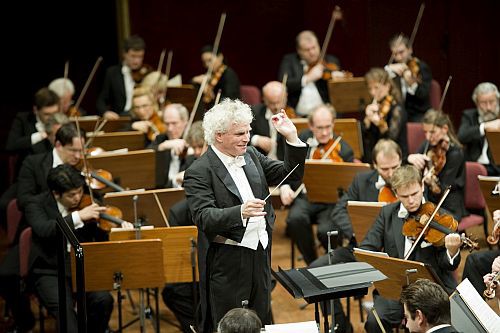 Germany Brahms, Haas, Debussy: Berliner Philharmoniker / Sir Simon Rattle (conductor), Philharmonie, Berlin, 22.2.2014 (SRT)
Germany Brahms, Haas, Debussy: Berliner Philharmoniker / Sir Simon Rattle (conductor), Philharmonie, Berlin, 22.2.2014 (SRT)

Brahms: Symphony No. 3
Haas: dark dreams
Debussy: La Mer
Sir Simon Rattle’s tenure at the Berlin Philharmonic will soon draw to an end. Who will be his successor, and where will he end up? It is too soon to say; but we should be grateful for the long period of goodbye because it gives us a chance to relish this Rolls Royce team for the short period that we’ll still have them together, and know that when he goes we will have lost something special. Hearing them in the Philharmonie (it’s their 50th anniversary in the hall this season) is a real privilege. They sound like a partnership that is entirely in step with one another, and they worked a special magic on everything they played.
For sheer excitement, this was the finest Brahms I’ve ever heard. Rattle kept the first movement moving forward with an unarguable sense of momentum so that everything felt just right, and the finale had a real harum-scarum sense of urgency to it. It was never just display for its own sake, however: behind the energy lay some tremendously exciting musicianship. Right from that opening fanfare, for example, the strings tore down the arpeggio that opens the main theme, but as soon as that phrase was completed Rattle drew them back, always holding something in reserve for later. That “later” came at the start of the coda, where that same violin theme was let loose with a fantastic sense of urgency that made the scalp prickle. Here was the work of a true musical architect doing his best with his home team on their home turf. That Berlin sound, so clear and so bright, felt as though they were putting Brahms under a microscope, showing up every glinting detail in the most precise manner. That wasn’t at the expense of subtlety, however: other moments, such as the clarinet themes of both the first and second movements, moved with thoughtfulness and, in the Andante, magical beauty. The cellos, so important to this symphony’s tonal colour, surged with the pulsing, urgent quality for which the Berliners are so famous. They were the particular beneficiaries of Rattle’s use of vibrato, unafraid to embrace it so that it pulsed through the sound like blood through veins, lending energy to that chocolatey, mahogany string sound that is the orchestra’s own.
The brilliant sheen of the string sound made this Brahms special, and the same qualities were apparent in La Mer, too. While listening to this, though, it was the sheer precision of the playing that struck me. The Berliners weren’t particularly renowned for their French repertoire before Rattle arrived with them (Abbado didn’t do much of it, and Karajan’s French recordings with the BPO have been accused of being too lax and indulgent). But he has turned them into a top-class band for Debussy and Ravel. His recordings attest to this too, but tonight’s playing simply sparkled all the way through. Every facet of Debussy’s kaleidoscopic score seemed to glint like a diamond being held up to the light, be it the harp chords, the meandering violins or the turbulent basses. There was never a hint of Karajanish gloop: instead this playing was precise enough to sound improvised, perhaps the highest compliment you can pay a Debussy orchestra, and nowhere more thrilling than when the brass brought the first movement to its climax. The highlight, though, was the astoundingly present shimmer on the high violins when the oboe solo reappears towards the end of the third movement, leading to the final wash of string tone that brings the music home.
The curiosity on the programme was the world premiere of George Friedrich Haas’ dark dreams. Rattle has championed Haas’ music during his time in Berlin, and a Philharmonie premiere is just about the highest compliment that can be paid to a contemporary composer. Haas didn’t let them down. Dark dreams is an enormously atmospheric work, full of suggestion, brilliant colour and also plenty of melody. Haas is keen on experimenting with quarter-tones (half the size of a normal semi-tone), and the quarter-tone trilling that began the work sounded like something from a horror film, appropriate enough considering the composer’s preoccupation with the night. The trilling swells and recedes like waves before some clarity emerges on the high brass, and the whole orchestra then begins to swing between two notes like a pendulum. An upward spiral of sound then emerges from the double basses and comes to be shared by the whole orchestra, climaxing in brilliant use of gongs and bells. Haas’ main technique is to introduce an idea for a small section and then build it up to ring out on the whole orchestra, and I found it very effective indeed, especially its conclusion, a doleful solo played first by the contrabassoon, then double bass and then tuba. How rare it is to hear those instruments get their moment in the sun! With its wave-like structure, and even a part for a rain-stick, it’s not a bad choice of companion piece for La Mer, and with an orchestra of magicians like this, it’s hard to imagine it sounding better.
This concert was relayed live via the Digital Concert Hall and can be viewed online.
Simon Thompson